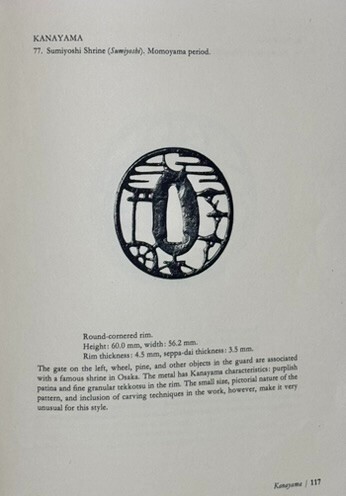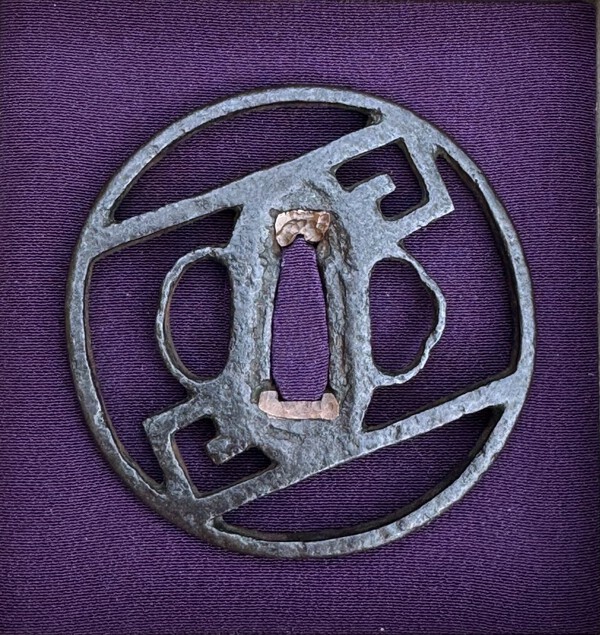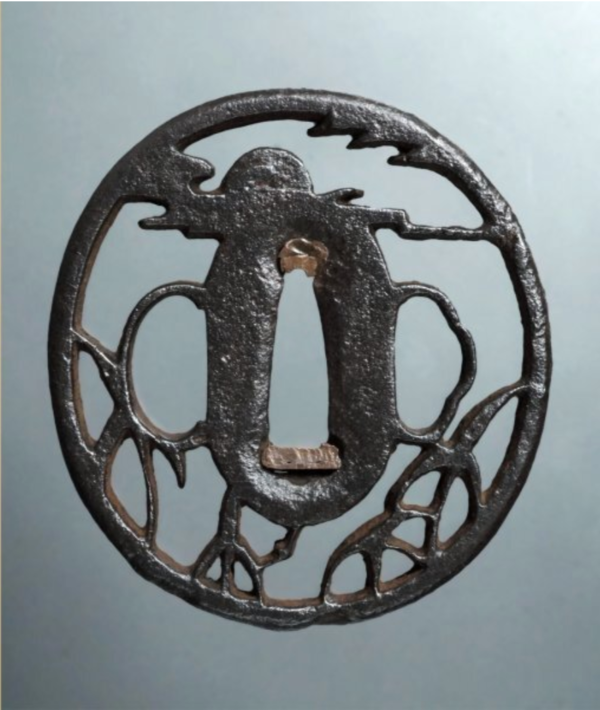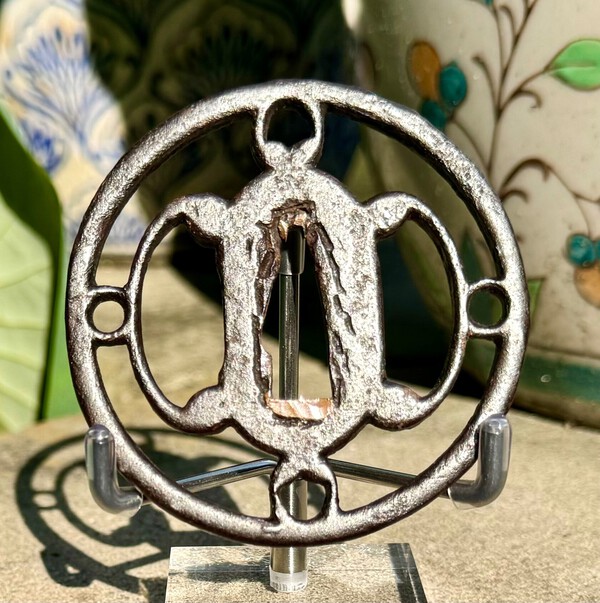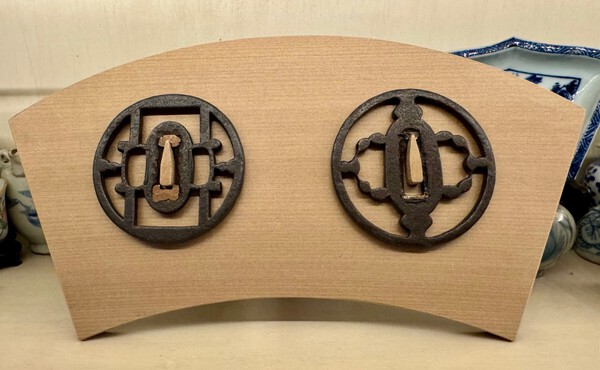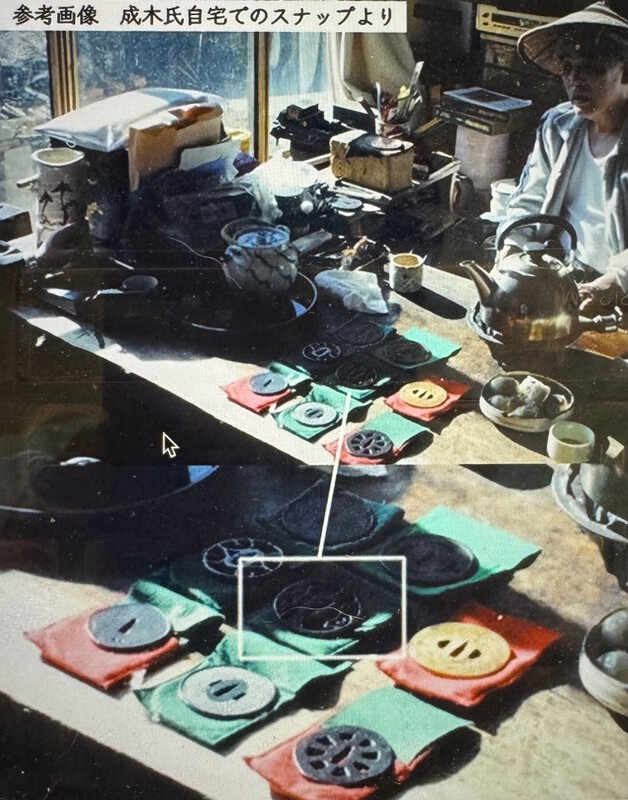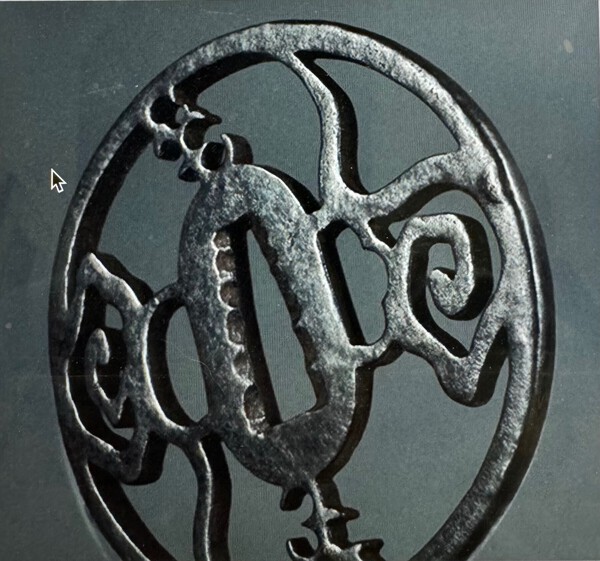-
Posts
307 -
Joined
-
Last visited
-
Days Won
2
Content Type
Profiles
Forums
Events
Store
Downloads
Gallery
Everything posted by Iaido dude
-
I think it is an utsushi in the Yagyu style with a motif that I've never seen before in Yagyu tsuba. It's a bit thin for the classic Yagyu tsuba. The appearance of iron is difficult to judge as "sandy" (not sure if it would appear differently with different exposure).
-

Kanayama follow up..... sort of- wabisabi influence
Iaido dude replied to Mantis dude's topic in Tosogu
Nice observation, Ken. This has the large dimensions of Ko-Katchushi tsuba with the seppa-dai thicker than mimi. Kanayama are smaller and thicker. Evolution doesn't often take place in discrete jumps, but rather incrementally. This may be such a transitional piece moving towards symmetrical and abstract sukashi elements that emerge as the other categories of early sukashi tsuba we are familiar with. -

Mumei Kanayama tsuba that point to a specific tsubako
Iaido dude replied to Iaido dude's topic in Tosogu
Here is another "grouping" of Kanayama tsuba (small size, lumpy tekkotsu), but with unusually pictorial imagery. Sasano doesn't quite argue that #1 and #2 are likely by the same smith, but he presents them together and describes them as unusual. If this is another distinct Kanayama workshop group, then the taste is more of the "rustic elegance" sensibility of Enshu's kirei sabi. An additional one (#4) from my collection (ex-Sasano, Gold book, #75) has the same yakite shitate "melted" surface treatment and hitsu-ana that are similarly if not identically shaped as those of #3 (especially the kogai hitsu-ana). -

Mumei Kanayama tsuba that point to a specific tsubako
Iaido dude replied to Iaido dude's topic in Tosogu
My argument is that, as often is the case for mumei tsuba and even when there is an identical name (but clear stylistic differences in execution) on tsuba with mei, in the absence of historical identification of named individuals or ateliers—the best we can do is to use our powers of inductive reasoning to observe the work of such distinct individuals or their workshops. We are in fact doing that through a community on this thread and have to be comfortable with uncertainty even as we do this because there is no other way. I think that relying on conflicting theories from a small group of “experts” will give a false sense of certainty and will not really move the needle forward. We must be discriminating and decide for ourselves whether any argument holds water. Additional analytical tools (eg using AI for more accurate identification, more detailed spectroscopic testing) may be brought to bear if validated. BTW, Sasano sensei often remarks on the likelihood that a specific tsubako made a number of tsuba that have striking similarities (gold book). So, this is by no means a new approach I am using to propose the existence of Hyotan-dai. -

Mumei Kanayama tsuba that point to a specific tsubako
Iaido dude replied to Iaido dude's topic in Tosogu
Point well taken, Tim. If not individuals, then a handful of workshops producing distinctive sub-styles of what we call Kanayama tsuba. Within a workshop it is not meaningful or possible to identify a named person since they are historically unknown. -

Mumei Kanayama tsuba that point to a specific tsubako
Iaido dude replied to Iaido dude's topic in Tosogu
Yes. My contention is that we have to use an inductive approach. Start with a description of notable features. Identify a “signature” that can group tsuba into a few distinctive groups. This signature serves to identify the tsubako in lieu of mei. Same principle. -

Mumei Kanayama tsuba that point to a specific tsubako
Iaido dude replied to Iaido dude's topic in Tosogu
Here is the $175 Kanayama tsuba I picked up somehow along the way in Singapore (about 2001) at an antique shop, not realizing what I stumbled on until a year ago when I saw it published in Owari To Mikawa No Tanko. It is just chock full of tekkotsu and dripping with Wabi Tea Ceremony aesthetics. It has punch marks around the nakago-ana. -

Mumei Kanayama tsuba that point to a specific tsubako
Iaido dude replied to Iaido dude's topic in Tosogu
I’m also a Kanayama/Ono lover. I only have one Ono. They seem to rarely come up for sale online (busy family life keeps me from attending shows). Here’s what Steve texted me from Japan, where he is wrapping up a visit: “My feeling is that they were likely made from the 1580s or 1590s through the Momoyama Period, so, maybe something like 1585-1615. Past 1615/1620, they would have become more Edoified, losing their vitality. It’s possible they could have arisen as early as the 1570s, but not before that, I don’t think. I would agree: perhaps as few as 3-5 smiths working in a small atelier. Almost certainly near the Yamakichibei atelier, as they share the same aesthetic sensibilities. 😉” -

Mumei Kanayama tsuba that point to a specific tsubako
Iaido dude replied to Iaido dude's topic in Tosogu
Excellent, Tim. I have an example of each of these in my collection. Again, in the absence of mei, I think it is possible to identify a small group of tsubako by the "signature" features of their works--in this case a kind of hallmark consisting of bevels and punch marks aroung the nakago-ana. -

Mumei Kanayama tsuba that point to a specific tsubako
Iaido dude replied to Iaido dude's topic in Tosogu
I’m referring to Steve Waszak’s study of the relationship between Kanayama tsuba and they Wabi Tea Ceremony aesthetic that they reflect. I have to go back to my notes and touch base again with Steve, but it is a very short period of time on the order of 30 years, give or take. -
Kanayama tsuba are thought to have been produced only during a 25-30 year period spanning the late 16th and early 17th centuries during the Momoyama and earliest Early Edo Periods. They reflect the aesthetics of the Wabi Tea Culture of their time. However, like all trends occurring in a small sub-population of refined connoisseurs (the buke in this case) amidst the rapid changes in sensibilities that accompanied significant transformation of the sociopolitical landscape, their demand and production were short-lived. We presume that there were, therefore, only a very small group of tsubako in Owari Province at the center of this artistic development. The problem is that none of their creations are signed. Is it possible, nonetheless, to identify individual tsubako based on characteristic features of their mumei works (e.g. motifs, composition, forging techniques, etc.)? Just as we have Shodai, Nidai, and Sandai masters of a particular school such as Yamakichibei (at least 5 masters and perhaps other smiths in their workshops). I submit two tsuba from my collection that I display together because they share so many features in common that they are highly likely to have been the products of a single smith or small atelier, whom I call “Hyotan-dai” (maybe someone can offer a better phrase) because of his apparent fondness for gourds as depicted in my two tsuba. This is speculative of course, but nonetheless compelling. Same iron forging technique (including tsuchime and tekkotsu), perfect marugata type, similar style of seppa-dai, square mimi, and same color/texture. In toto we see a defining profile of his workmanship.
-
All highly cringeworthy. I do find it tragic to find an otherwise rare and desirable tsuba that has been severely damaged or purposely ruined.
-
Perhaps we should include tsuba-shaped or tsuba-like items that make one’s skin crawl. The tsuba-shaped paper weight I posted commemorates the Japanese Imperial Army occupation of Manchuria (1931-1945). It clearly has collecting value by the looks of that auction. As cringe worthy to me as this ash tray.
-
Gifu prefecture appears to be a very active swordsmithing region. My new custom iaito is en route from there after months of waiting.
-
There are several forged tsuba of this “model,” it seems so you may have seen this composition before if not this specific one. He’s quite good, but the price tag on this is actually quite a bit higher than several Kanayama Suba that I own. I was just fortunate enough to recognize what I was buying for bargain prices in the past. Still, I find his work to be very good. I might be in the market for a very convincing Nobuiye utsushi.
-
These can be tsuba you own or have seen elsewhere. Here’s one that inspired this thread. Enough said. https://www.jauce.com/auction/t1177198028
-
Bravo, although I wonder what specific features tipped you off. Noriki is a master contemporary smith who was born in the first half of the 20th century. He creates exquisite utsushi of Owari province guards of the late 16th and early 17th centuries. I didn’t include a pic of the ura with his mei on purpose for this exercise because I want to make a point about the significant flaw of attribution on the basis of the color and surface treatment of iron sukashi tsuba as propagated by Sasano sensei and his students. The smiths who created Owari province tsuba were highly skilled at forging iron plates with surface treatments to express many different styles and artistic sensibilities (e.g. wabi, sabi, mono no aware, yugen). The Noritsuke school and contemporary smiths like Noriki can likewise create these effects including tekkotsu and yakite shitate. The last photo below shows a tsuba (encircled) of the identical composition in Noriki’s workshop. Just look at the array of styles and composition and features on display among his creations. He creates homage pieces with his mei. We were all “fooled,” which attests to Noriki’s artistry and immense skill. https://www.jauce.com/auction/m1177516137
-
It really does appear to be. The size is a bit bigger than most Owari, but there are always exceptions.
-
I think that the features are consistent with Owari or Kanayama, but stay tuned. The rim is square. Nearly all Akasaka have rounded rims. It is dished, whereas Akasaka guards are thicker at the seppa-dai and thin towards the mimi. And tekkotsu are generally not found on Akasaka. I also find this tsuba very compelling. It has a fluidness and vitality that I associate with Kanayama and Wabi Tea Culture. However, the karigane appear to be more recent than Momoyama and Early Edo in their styling and execution (hence the Akasaka feeling).
-
Here is a tsuba I saw online. I think it would be instructive to get a consensus on its attribution including “school” or specific smith, period of production, and motifs. It has a square rim and what appear to be globular tekkotsu on the mimi. Dimensions: 82 mm x 80 mm, 5.7 mm (mimi), 4.9 mm (seppa-dai).
-

Christian Ship Tsuba (Is This Really an Ono Kozeho?)
Iaido dude replied to Iaido dude's topic in Tosogu
Another possibility is that if it is crucifix and these tsuba were made after the beginning of the Christian persecution in Japan as utsushi of the Ohno or Yagyu styles, it would set the date to after the earliest Edo Period for the emergence of another form of disguised Christian expression of faith. This would be just as in the case of Ikenie tsuba as they began to soften and then become disguised. If we can argue about whether the motif is religious or a practical maritime device it seems possible that that argument could’ve been made in a historical context by the faithful. It would be a testament to the enduring power of religious faith and the persistence of personal and political protest—even in the face of persecution and the threat of death. This is why Fred calls these tsuba a sacrifice by Japanese Christians. -
Yes. There is a special bent saya chisel that is often used. The only way for me to pull this off without the long hours over a long period of effort to acquire these skills is to use a router and precut template. I do this a lot on guitars. It’s cheating, but it gives a very precise way of achieving the goal. I tightened the koiguchi by gluing a thin veneer on the narrow side. To prevent rattling inside the saya, changing my technique for resheathing can go a long way.
-

Christian Ship Tsuba (Is This Really an Ono Kozeho?)
Iaido dude replied to Iaido dude's topic in Tosogu
I think you win the argument just for using the term "parsimonious." In medical practice and teaching, we often refer to the rule of parsimony by invoking Occam's razor! The difference here is that in so far as tsuba are an art form and an historical culture-bearer with elements that are often chosen for their meaning and symbolism rather than for the sake of simplicity, I don't think parsimony necessarily applies. I don't know why there is that curled element to the bow. I noticed it as well. I suspect that it is a stylized rendering. What is striking is that this element appears in all of the examples even as some of the other details vary slightly. The one on auction has a rendering of the rope as having coils, which lends texture to this element. -

Christian Ship Tsuba (Is This Really an Ono Kozeho?)
Iaido dude replied to Iaido dude's topic in Tosogu
Thanks, Justyn and Florian. It seems that the capstan was invented in the 14th century and gets its derivation from the Spanish or Portuguese, which would support the theory that the ship depicted is Portuguese. The question is whether a capstan was worthy of being singled out. The careful rendering of this motif is so specific and intentional that I find it hard to believe that it is not in fact emblematic of a Portuguese Jesuit ship. The form of the composition of the sail does seem to take its inspiration from the Yagyu and Ono depictions. The top of the sail is rendered the same way even on the woodblock prints--a stylistic element. What is remarkable is that the many examples of this tsuba composition are nearly identical (if anyone has an image from the Compton Collection or Nakamura's Tsuba Shusei, please post). There seems to be a demand for this image. It was somehow very meaningful. -
Aside from Fred's published article in which he coins the term "Ikenie tsuba" as the most appropriate way to refer to these Shakoh tsuba (as opposed to Tokei), I only have a monograph on tsuba with Christian iconography purchased on Jauce and an article from the shared NMB archive (On Esoteric Buddhist Iconography in Early Japanese Matchlocks by A. Goetz). Interestingly, the monograph doesn't actually feature an example of Ikenie tsuba. Some of the purported Christian symbolism is a bit of a stretch. Others are quite compelling, including the one on the lower left of the cover (not geese in a ring). These are the only dedicated references that I have for religious iconography appearing on tsuba. I'm sure there are others, but my reference library is rather limited. On_Esoteric_Buddhist_Iconography_in_Earl.pdf




